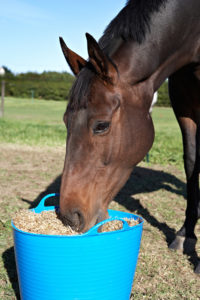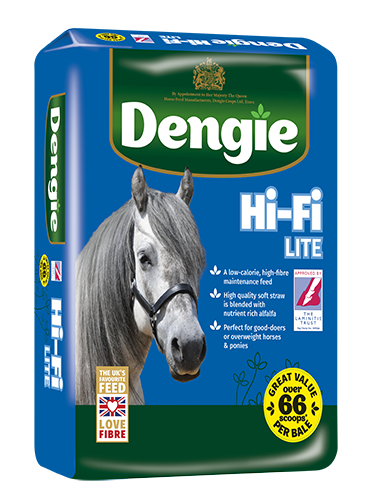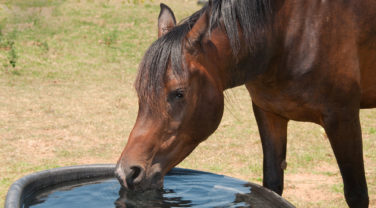Feeding your horse during dry conditions
Article last updated: 6th July 2022
Whilst we have all been enjoying the hot and sunny weather there is no doubt that the grass is suffering with brown, bare paddocks a common sight. These conditions also increase the risk of dehydration in horses particularly if they are in hard work. More people contact the Dengie Feedline asking ‘do horses need hay in the summer’ when the grass quality declines which tells us this issue is causing concern amongst horse owners. So what does a hot, dry spell mean for our grazing and the horses on it?

How to cope with bald paddocks
Firstly a hot, dry spell will eventually lead to a limited amount of grazing for horses as growth slows due to the grass becoming stressed as a result of a lack of water. Horses that are on the paddocks will continue to consume what’s available, cropping close to the ground leaving a bald, patchy paddock.
One of the first consequences of this is that any horses grazing continually on the same paddock will have less to eat. It is important to remember that horses are herbivores that have evolved to eat on a little and often basis and that fibre is pivotal to their digestive and behavioural health. Problems such as loose droppings and colic can all be indicative of low fibre diets. Owners of horses grazing sandy soil will need to be particularly aware of the risks of sand colic as the horse picks up sand more easily when grazing shorter, sparser grass.
How much grass is my horse consuming?
All horses and ponies should have at least 1.5% of their bodyweight on a dry matter basis of fibrous feeds daily. For a 500kg horse this would equate to 7.5kg daily. So how much grass is your horse consuming when out? Unfortunately this is a really difficult question to answer as under practical conditions it is impossible to determine intake. One way to ascertain if your grass is still actually growing is to fence off a small area within the paddock that your horse is grazing and to monitor it. If the grass in this patch greens up and grows then it suggests the grass in the rest of the paddock is growing, it’s just your horse is eating it before you see it! Another good tip is to monitor the amount of droppings your horse does. A reduction in the number of droppings will generally mean that there has been a reduction in intake.
Do horses need hay in the summer?
If your paddock is really bare and the grass isn’t growing then you may ask yourself ‘does my horse need hay?’. The answer is usually yes, as your horse should have access to additional forage to maintain their digestive and behavioural health. A bare paddock can very quickly lead to paddock hopping or electric fence destruction if the grass is greener on the other side! However the quantity and type of forage given depends on the individual horse.
How soon can I feed new forage?
Another question we commonly get on the Dengie Feedline is ‘how soon can I feed new hay to my horse?’. Hay can be fed post-harvest as long as there is no heating in the bales. The important point here though is that introducing the new hay will constitute a large change in diet and if this is done rapidly it could result in digestive upset. Any dietary change should ideally be made gradually by mixing old and new hay together over the period of at least a couple of weeks. Feeding hay in greedy feeder nets will also help to slow the rate of intake and prevent sorting or selection of purely the new hay.
Haylage needs to be stored for at least 6 weeks or longer post baling prior to feeding. This is because it takes time for the preservation process to take place that is promoted by the removal of oxygen. Again the same rules regarding dietary change apply when introducing new haylage.
If forage is still in short supply then hay replacers can be used to extend or replace the forage ration. Whatever forage source you use, make sure the top up you use is appropriate to the individual and particularly their bodyweight.
Feeding good do-ers on bald paddocks
 Whilst there are many brown and bald paddocks out there it cannot be denied that there are still many overweight horses and ponies grazing on them that don’t particularly appear to be losing weight.
Whilst there are many brown and bald paddocks out there it cannot be denied that there are still many overweight horses and ponies grazing on them that don’t particularly appear to be losing weight.
If you have established that the grass really isn’t growing then it is still important to provide an appropriate fibre intake even for horses that need to lose weight. We just have to be clever with the fibre sources we choose in order to achieve this. For good do-ers a later cut, more fibrous hay would be the best option. The later the cut and therefore the more fibrous the hay the lower in calories it will be. This can only really be determined by analysis and unfortunately many hays in the UK won’t actually be that low calorie and will still provide the horse at rest or in light work with more energy than they need. Feeds and forages of 8MJ or less of digestible energy are considered low calorie.
Straw is a useful low calorie fibre source that can be blended with the hay ration to reduce the overall calorie intake. Current advice is to feed up to 30% of the ration as straw. Hi-Fi Lite is a great option for good do-ers that need a part or total hay replacer ration. Hi-Fi Lite combines straw with high temperature dried alfalfa and a light molasses coating.
Feeding poor do-ers on bald paddocks
Whilst some horses appear to live on ‘fresh-air’ there will be those who drop weight quite rapidly when the grass disappears. Ad-lib forage is advised for all horses that don’t hold their weight easily. Haylage and earlier cuts hays on the whole will be more nutritious and energy dense for these horses. Before reaching for traditional mixes and cubes to fill the energy gap, fibre can also be made more of in the bucket feed to help with weight maintenance, or higher calorie hay replacers used if only poor quality forage is available.
Any of the Dengie Alfa-A range of Fibre Feeds which are based on pure alfalfa can be used as a means of topping up or extending poor quality hay. Up to 500g per 100kg of bodyweight can be fed daily which equates to 2.5kg for a 500kg horse.
Dengie Meadow Grass with Herbs & Oil and Alfa-Beet can also be used as partial hay replacers. Meadow Grass with Herbs, combines chopped and pelleted grasses with a rapeseed oil coating and herbal blend, can be fed up to the rate of 1kg per 100kg of bodyweight daily as long as it is not fed alongside any other high oil feeds. Alfa-Beet which combines alfalfa and unmolassed sugar beet with a 2 hour cold soak or 15 minute hot soak time can also be used to partially replace forage up to the rate of 1kg per 100kg of bodyweight daily when fed to replace any additional alfalfa or beet element of the ration. As Alfa-Beet is fed soaked it is also useful for helping to maintain hydration and to mask the taste of added electrolytes as well.
If a total forage replacement is required Dengie Hi-Fi Senior,Dengie Pure Grass and Dengie Pure Grass Pellets are the best option for poor do-ers. Hi-Fi Senior combines high temperature dried grasses and alfalfa with a light molasses and oil coating. Pure Grass is simply a naturally nutritious 100% chopped grass feed with absolutely nothing else added. Pure Grass Pellets are just that – pure pelleted grass with nothing else added. Pure Grass Pellets when fed alone should be soaked to a mash.
| Product | Digestible Energy MJ/kg | Sugar % | Starch % |
|---|---|---|---|
| Hi-Fi Senior | 8.5 | 10 | 1.6 |
| Pure Grass | 10 | 12 | 2 |
| Pure Grass Pellets | 10 | 12 | 2 |
Can my horse or pony get laminitis grazing on a bare paddock?
Whilst grass looks mostly brown and dead at the moment this does not mean that it is low in sugar as well. In fact when grass is under stressful conditions it accumulates more sugar as the plant is still photosynthesizing, but as the grass isn’t growing the sugar is stored rather than used. Fructan is the storage sugar in grass and is mostly stored at the base of the plant -precisely what the horse is eating when cropping close to the ground.
Whilst the amount of grass available to eat on a bare paddock does potentially limit the amount of sugar consumed care should be taken with individuals who have underlying insulin dysregulation issues who may be particularly prone to laminitis. Those with insulin dysregulation don’t have a normal response to the intake of non-structural carbohydrate which is the sum of sugar or water soluble carbohydrate, fructan and starch added together. Insulin dysregulation results in higher than normal levels of insulin circulating in the blood and results in a higher risk of laminitis.
The problem increases when we do eventually get rain and the grass greens up and starts to grow again. Fructans are converted back into more simple sugars to allow the grass to grow and so grass at this time has a higher level of non-structural carbohydrates. Even though the amount of grass available initially to eat is still sparse, this could still be enough to trigger laminitis in susceptible individuals. As such, for laminitis prone horses and ponies it may be best to remove them from pasture at this time and feed an appropriate forage based ration which contains less than 10-12% non-structural carbohydrate ideally.
For further feeding advice or answers to similar questions like ‘do horses need hay in the summer’ call our Feedline on 01621 841188. If you would like our nutrition team to review your horse or pony’s current ration click here to fill in our Feed Advice form.



